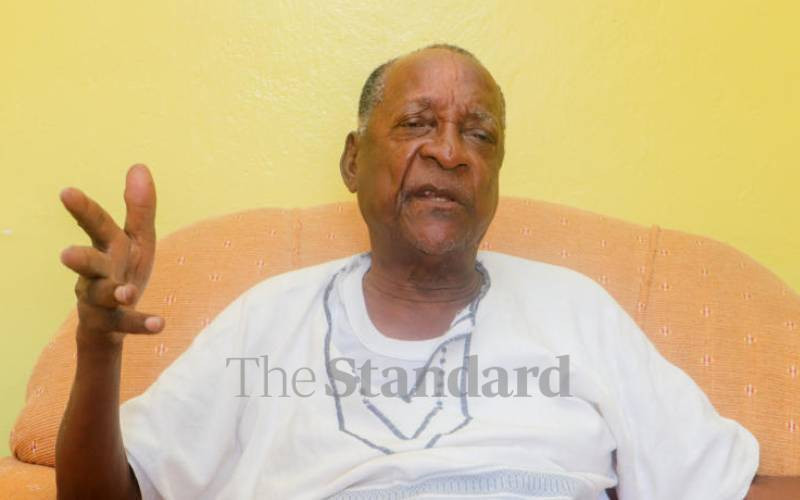
A wave of nostalgia sweeps across Henry Joy Farah's ageing face as he gazes at a cemetery behind Kongowea Market in Nyali Constituency, where he says the remains of his forefathers lie.
At a distance, an elderly woman and a young boy are deeply engrossed in conversation while strolling through the cemetery exclusive to descendants of former slaves from Frere Town area.
Farah, 56, the Secretary of Frere Town Descendants Community Association, glances at the two and remarks: "She's passing on our sad history to the boy and showing him graves of his ancestors."
In Mombasa, burial yards are divided into tribes, families, or religious lines. For example, Kikowani Cemetery is divided into four sections - Thalatha Twaifa of the Waswahili; Tisa Twaifa for Arabs (Hdhrami), and the Baluchi - same as Mbaraki, Saragoi and Ganjoni for other segments of the society.
For the last 133 years, the seven clans of descendants of ex-slaves - Farrah, Mbotela, Mitchaer, Mponda, Mochira, and Manasseh - who fondly call themselves Freretownians use Kongowea Frere Town Cemetery.
The ancestry of these ex-slaves is a mystery. Their family trees go back to when their forefathers were rescued by the British Naval Force and settled in Mombasa.
In the 19th century, Mombasa and other coastal towns were major transit points for slaves transported to East Africa's biggest market in Zanzibar to be sold and later shipped to other parts of the world.
Historical accounts show that Freretownians' forefathers were freed by British naval soldiers led by Sir Bartle Frere in the 1870s while en route to Zanzibar. They were settled on a 600-acre land in Mombasa.
Their settlement scheme started at Nyali Bridge, north of Mombasa island, and straddles the present-day Nyali, Mkomani, Kongowea, Bombolulu, and Mishomoroni areas.
Andre Mwambira, a Freretownian elder, says they have been squeezed into a 50-acre land in Frere Town in Kisimani, Nyali Constituency. Some have however moved to other parts of the country.
Famous sons of the Freretownians are former Bahari MP (now Kilifi South) and former State broadcasters Joe Khamis, and Leonard Mambo Mbotela.
Others are Mzee Joseph Ngala, the founder of the Bango music who still lives in Frere Town and Ishmael Semler the first ex-slave and African to be ordained to the Anglican Ministry.
But Frere Town area also has its ugly side. Over the years it has gained notoriety as the bastion of dreaded criminal gangs like Wakali Kwanza and Wakali Wao, and a place where drug abuse is rampant.
However, Farah and Mwambire argue that the present Freretownians have blended ancestry following years of intermarriage with local communities like the Mijikenda, Kamba, and Swahili tribes, therefore the criminal gangs cannot be blamed on their community alone as other tribes now live in the area.
"The intermarriage accelerated after it became apparent that that was the only way we could get the National Identification cards and jobs," said Farah, registered as a Kambe.
For years, the inhabitants of Frere Towns have tried to preserve their story, heritage, and culture of their ancestors from Nyasaland (present-day Malawi), Mozambique, and parts of Tanzania. It has not been easy.

"The sad part is our history in Kenya is also gradually being erased. Even the Old Vicarage house at Frere Town is now under the ACK Emanuel Church Kengeleni," Farah says.
ACK Emanuel Church, built in 1889, has been a subject of wars between the Freretownians and the leadership of the church archdiocese.
Dr Johann Ludwig Krapf built the first church in Rabai, Kilifi County. The ACK Emanuel Church is near the Kengeleni junction and Kongowea Market, off the controversial Fidel Odinga Road.
Historical accounts indicate that the church was built exclusively for freed slaves living in Frere Town. Farah says the church was built by his ancestors from 1887 to 1889.
"The church was built using marram sand from the shores of the Indian Ocean. It was exclusively for our forefathers to worship. We ran the church until 2007," said Farah.
Other historical accounts indicate that the floor of the church was made using unique materials that were washed to the shores by huge sea tides. This account goes that some 135 years ago, a tsunami hit the shores of Japan and huge plants were washed to the shore of the Indian Ocean along the Kenyan Coast by huge tidal waves.
The slaves collected these plants which they later used to construct the floor of the church that was first called the Church Province of Kenya (CPK). The church was first led by Cannon Rev Harry Kerr Binns.
In recent years, the wrangles have hit the church. According to court documents, descendants of ex-slaves like Fredrick Uledi, Baron Katana, and Farah object to management changes.
"The church was given to us by the missionaries. The case is dormant after the death of leaders," said Farah. He said the tussle has interfered with their tradition of praying for the dead.
Although most of the Freretownians are Christians, they believe that praying for the dead on Saturday will enable their spirits to rise to purgatory or what is called Abraham's bosom on Sundays.
In the court papers, they claim there was an effort to erase the history of the church citing the change of its name from ACK St Emmanuel Church Frere Town to ACK Emanuel Church Kengeleni.
Farah said that the huge bell or 'kengele' at Kengeleni near the Kongowea market is a constant reminder of the slavery era, during which it was rang to warn people when Arab slave ships were sighted.
The bronze bell is a replica of the original one that weighed 300kg, currently kept in Nairobi, following attempts to steal it between 1987 and 1988. The bell was used to alert slaves whenever ships of slave raiders were sighted at the port of Mombasa.
"The bell is a reminder of what our ancestors went through," said Farah. The bell is just opposite the ACK Emanuel Church.

Opposite the bell is a building that housed the first CPK Church Missionary Society Frere Town, the divinity school for training evangelists, established in 1889.
"As you can see the place that housed the first CMS has now been turned into a motorbike showroom. The divinity school was moved to St Paul's United Theological University in Limuru," said Farah.
A school was also built for the ex-slaves to be taught technical work like masonry, knitted dolls, and mats. "A primary school was also established and named Binns Primary School, after Rev Binns."
At Frere Town, the Old Vicarage house was once owned by one of the ex-slaves' descendants named Nyanya Bikizaya.
It is said that Bikizaya never bore a child and before her death, she directed that the house should be used by the ACK clergymen.
"She died of old age in the 1970s. And because she did not bear children, she wanted her house to be used by the church clergy," said Farah.
Despite the horror of the tales of their forefathers, local tribes especially the Mijikenda and descendants of the Arabs at the Coast are said not to have accepted them because of their close links with the colonisers.
"There's a sense in which the locals still perceived the Freretownians as collaborators and that is why it took over a century for them to be recognised as one of the tribes of Kenya," said Joyce Kadenge, a historian.
She said one of the ex-slave descendants, Tom Mbotela, who was a councillor in Nairobi, was killed by the Mau Mau fighters in the 1950s for allegedly being a collaborator.
"Mbotela Estate in Nairobi is named after that councillor who was a Freretownian," said Kadenge adding that the Freretownians were loyal servants of the colonisers.
And, according to Julius Ogogoh, a human rights crusader, the 2010 Constitution and other laws have failed to recognise the Freretownians as a tribe in Kenya leading to their marginalisation.
"The Freretownians are now seen and recognised like other minority tribes like the Nubians, Somalis, and Makonde within the Kenyan society," said Ogogoh.
 The Standard Group Plc is a multi-media organization with investments in media platforms spanning newspaper print
operations, television, radio broadcasting, digital and online services. The Standard Group is recognized as a
leading multi-media house in Kenya with a key influence in matters of national and international interest.
The Standard Group Plc is a multi-media organization with investments in media platforms spanning newspaper print
operations, television, radio broadcasting, digital and online services. The Standard Group is recognized as a
leading multi-media house in Kenya with a key influence in matters of national and international interest.

